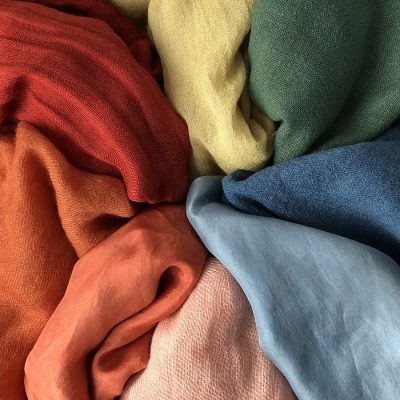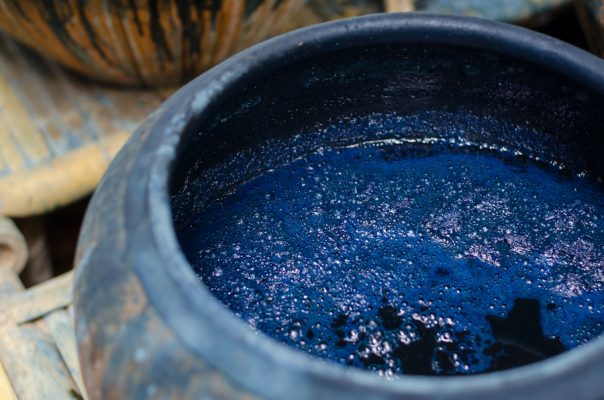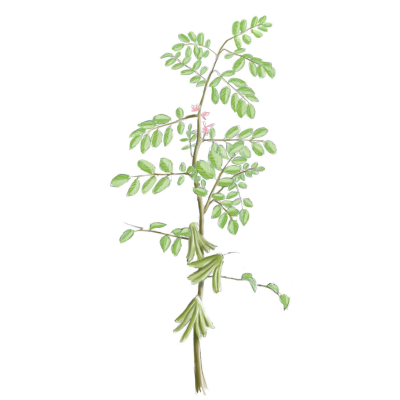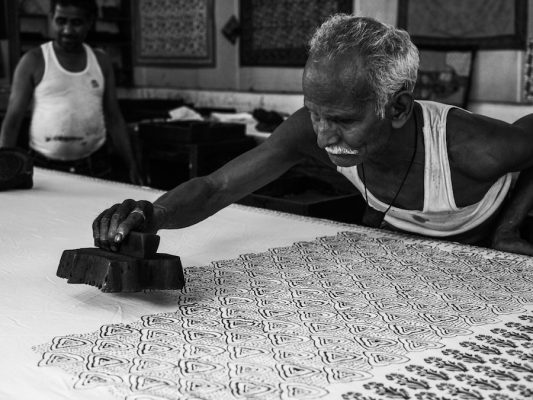We are nowadays talking more and more about natural dyes. This ancestral know-how interests consumers looking for unique, ethical, and ecological fabrics with many benefits for the people who wear these dyed fabrics and of course for those who produce them.
Today, we give you 7 excellent reasons to make a switch for your textile collections or personal creations.
So here we go!
#1 – A varied and unique colour palette

Nature offers us multiple possibilities of colours to dye fabrics. Naturally produced colour carries subtle and harmonious shades. Synthetic colours could never imitate them.
These colours are “alive”, they evolve with time, in the shade or in the sun, and the shades are also slightly different.
All the plant colours are harmonious together because the plants from these colours can have various dyeing principles. Madder for example has 19 different ones, which explains the incredible variety of shades and colors that can be obtained with this plant…. Unbeatable by the synthetic 😉
#2 – Choosing natural dye is protecting our environment
Indeed, natural dyes are not harmful to the environment since they come 100% from natural and renewable sources. They are obtained from plants, fruits, minerals or insects.
Moreover, it consumes less water than synthetic dyes. The dye and wash baths can be reused several times.
The natural indigo vat, for example, can last for months. Simply replenish it with the necessary ingredients.

Indigo vat
It is also important to remember that synthetic dyes, which appeared at the end of the 19th century and developed in large quantities at the beginning of the 20th century, are derived from petroleum!
At a time when the scarcity of this resource is becoming a global issue, they are no longer a “utopia” but a subject that deserves the interest of researchers and industrialists in order to find sustainable and environmentally friendly dyeing solutions.
#3 – They are particularly suitable for sensitive skin
Since they do not contain any harmful products, plant-dyed textiles can be suitable for all skin types especially the most sensitive such as babies for example.
By the way, did you know that babies’ skin is said to be “immature” until the age of 3?
Conversely, synthetic dyes can be very dangerous for our skin and health, such as the carcinogenic azo dyes that have only been banned since 2003 in Europe (see article 3 bibliography to learn more about the risks associated with these synthetic dyes). Moreover, it is almost certain that some products authorized today will one day be banned because they are too dangerous…
#4 – Natural dyeing gives certain particularities to fabrics
 It is important to know that many natural dyes have antimicrobial and hypoallergenic properties. This makes them a great asset to replace synthetic dyes in your wardrobe!
It is important to know that many natural dyes have antimicrobial and hypoallergenic properties. This makes them a great asset to replace synthetic dyes in your wardrobe!
Finally, did you know that a majority of dyeing plants have medicinal properties? Yes, plants develop these molecules at the origin of colours to protect themselves against predators, attract pollination or those who spread the seeds.
Dominique Cardon, a specialist in natural dyes, confirms it: “80% of dyeing plants have medicinal virtues”.
For example, indigo was traditionally used as a healing agent (bandage in Yemen) but also as an insect repellent. Turmeric, for example, is an anti-inflammatory and antioxidant.
It has also been shown that sandalwood extract prevents the development of skin tumours and has antiviral activity against herpes simplex (Dwivedi and Zhang, 1999 / Benencia and Courreges, 1999).
#5 – The ingredients used are biodegradable
The ingredients used in natural dyes are 100% biodegradable and this is a major asset for our environment.
Synthetic dyes, on the other hand, which are derived from petroleum, pollute a lot because the wastewater, which is still insufficiently recycled, is discharged directly into the rivers or streams around the factories. (To read: the sad story of the city of Tirupur in India. cf Biblio 6)
It is still important to indicate the importance of recycling the dyeing water as well, which is the case for example for GOTS-certified fabrics. Even the water used for these dyes, if used in large quantities must be recycled because although the ingredients are biodegradable, they remain an aggression for the environment which naturally would never receive this amount of products.
#6 – It protects the skin from UV rays

Natural dyes offer better UV absorption in the fabrics on which they are used. By wearing naturally dyed clothing, you are therefore able to better protect your skin from the sun’s harmful rays.
Studies have been carried out at the University of Colorado comparing the UV protection of fabrics dyed with natural dyes and fabrics dyed with synthetic dyes. It turned out that the skin was better protected with naturally dyed fabrics.
The darker the dye used, the better the UV protection is. This is the case with textiles dyed with Indigo, Madder, and Cochineal for example. Also, the more concentrated the pigment is in the fabric, the better the protection is.
It has also been proven that carotenoids, which are pigments (mainly yellows and oranges) present in these dyes, have a strong resistance to UV rays (see bibliography 9).
#7 – Valorization of an artisanal know-how
The work of natural dyeing is mainly artisanal. There is, therefore, a strong need for labour, thus providing employment opportunities for all those involved in the cultivation, extraction, and work of these dyes.
Developing these recipes takes time and requires a lot of testing in order to obtain the desired colours that will last over time.

The natural colours are derived from mixtures of plants, fruits, and minerals. Different dosages of each pigment can therefore give a different color or shades from one dye bath to another. This requires perfect control of the dosages and dyeing times.
The dyers who specialize in this know-how can all confirm it, it is very difficult to obtain a perfect result with each production because many factors come into play (techniques, plants, types of fabrics …). It is not an exact science and this is what makes the beauty and uniqueness of these fabrics.
That’s also the magic of craftsmanship, isn’t it?
Also Read: Artisanal Weaving – Kala Cotton
We hope that this article will convince you about the benefits of natural dyeing for your textile creations. So, what are you waiting for to work with natural dyeing?
We are at your disposal to discuss it by email at contact@fibrebio.com.
If you are interested in this topic we recommend the following articles.
Bibliography:
1) https://tinctoriales.com/en/couleur/
2) http://www.ecotintes.com/en/content/why-natural-dyes
4) Le monde des teintures naturelles – Dominique Cardon
5) Couleurs végétales – Michel Garcia
7) https://www.modeintextile.fr/developpements-domaine-colorants-naturels/
8) http://www.theses.rnu.tn/fr/dynamique/uploads/22f76ed3b286d14c6034da020180ba41.pdf
9) https://www.intechopen.com/books/chemistry-and-technology-of-natural-and-synthetic-dyes-and-pigments/fundamentals-of-natural-dyes-and-its-application-on-textile-substrates
10) http://ecotintes.com/fr/content/teintures-naturelles-une-plus-grande-protection-uv


 Français
Français